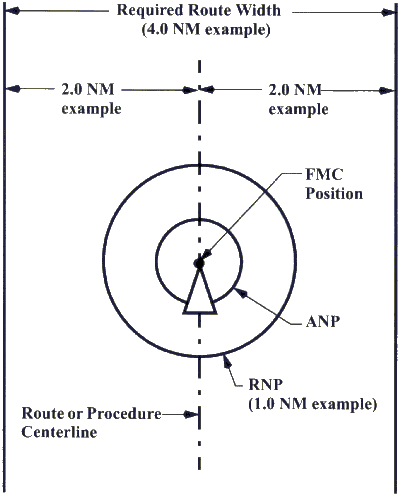RNP and RNAV Operations
FCTM This section describes the basic concepts of RNP and provides information on RNAV operations by phase of flight to include terminal (SIDs and STARs), en-route, and approach.
Basic RNP Concept
RNP has been developed through international cooperation as a means of identifying the navigation performance required for a specified area, route, airspace, procedure or operation. RNP supports use of RNAV systems that use multi-sensor position updating methods such as the flight management computer (FMC). This accuracy is specified in NM (e.g., RNP 0.3 means the performance required is within 0.3 NM). RNP values are usually smaller for terminal area procedures (SIDs, STARs, approach transitions, and approaches) than en-route procedures. Small RNP values normally require navigation performance that is more precise than current VOR/ADF navigation, allowing lower weather minima for departures and/or approaches.
The FMC uses one of the following as the displayed RNP:
- default RNP - FMC default values are set by the FMC and are displayed if no RNP is available from the navigation data base or one has not been manually entered
- navigation Data Base RNP - RNP values (if available) are displayed based on values associated with the procedure. These values may be unique for certain segments or terminal procedures
- manually entered RNP - remains until changed or deleted.
The crew may need to make a manual RNP entry if the displayed RNP for the route or procedure is incorrect. Setting an RNP smaller than what is specified for the procedure, airspace, or route, may cause nuisance crew alerts. If the RNP is larger than required for a procedure or segment, inadequate alerting results if needed. Operators should select FMC default values that meet the requirements of their route structure or terminal area procedures. However, AFM requirements may specify RNPs for certain approaches. (For example, RNP 0.3 is required for RNAV (GPS) approaches).
The FMC calculates and displays its Actual Navigation Performance (ANP) as described in the FCOM. When the ANP exceeds the RNP a crew alert is provided.
When this occurs on a route or terminal area procedure where an RNP is published, the crew should verify position, confirm updating is enabled, and consider requesting an alternate clearance. This may mean changing to a non-RNP procedure or route or changing to a procedure or route with a RNP higher than the displayed ANP value. Crews should note that ANP is only related to the accuracy of FMC position. Lateral deviation from the route or procedural track is indicated by the XTK ERROR (cross-track error) value shown by the FMC. LNAV should be used with the autopilot engaged to minimise cross-track error. Excessive XTK ERROR does not result in a crew alert.
The following illustration shows the FMC position and displayed ANP and shows the relationship of ANP to RNP for a particular route segment. Normally, a route segment or procedural leg is defined by its required width (the illustration shows 2.0 NM either side of the centreline). RNP is normally set at 50% of the allowed maximum deviation from the route centreline. Required width is determined by minimum terrain or traffic clearance requirements. The probability of exceeding this maximum deviation while in LNAV with the autopilot engaged is very small. For each airplane type, minimum demonstrated RNPs are given in the AOM. These minimum values vary depending on LNAV, flight director and autopilot use.
RNAV Route and RNP/ANP

RNAV Operations: En-route, Terminal, and Approach
All Boeing FMCs are capable of performing RNAV operations. Regarding navigation accuracy, these FMCs differ only by demonstrated RNP capabilities and the ability to use GPS updating.
En-route operations can be defined as oceanic and domestic. Oceanic RNAV requirements are described in detail in the applicable MNPS guidance material such as the Pacific or North Atlantic manuals. Specific routes or areas of operation are given RNPs based on route separation requirements. RNP 1.0 routes are suitable for all FMCs that are capable of GPS updating and those FMCs that cannot update from GPS but have received the last radio update within the previous six hours.
In general, oceanic operations require dual navigation systems (dual FMC or single FMC in combination with alternate navigation capability).
Domestic en-route RNAV operations depend on the availability of radio updating (DME-DME) sources to support domestic RNPs. The following domestic RNP operations are fully supported by any Boeing FMC with DME-DME or GPS updating active:
- USA and Canada - RNP 2.0 or higher
- Europe - B-RNAV (RNP 5.0)
- Asia - As specified for the route or area (e.g. RNP 4 or RNP 10 routes)
- Africa - As specified for the route or area
Terminal RNAV operations (SIDs, STARs and Transitions) are fully compatible with all FMCs with DME-DME or GPS updating active and are defined as:
- USA and Canada - RNP 1.0 SIDs and STARS
- Europe - P-RNAV (RNP 1.0)
Note: For P-RNAV and certain other RNAV departures, airplanes without GPS updating may be required to accomplish the Fast Realignment Supplementary Procedure prior to departure to ensure sufficient position accuracy after takeoff until DME-DME updating commences.
RNAV approaches are compatible with all FMCs provided DME-DME or GPS updating is active at the beginning of the approach and the approach RNP is equal to or greater than the minimum demonstrated RNP in the AM. Restrictions published on some RNAV approaches may preclude their use without GPS updating active.
For published RNAV approaches, all Boeing FMCs have RNP 0.5 capability with DME-DME updating active without GPS updating. See the Approach section of this manual for further details regarding the techniques for flying RNAV approaches.
Boeing Flight Crew Training Manual - Section 1